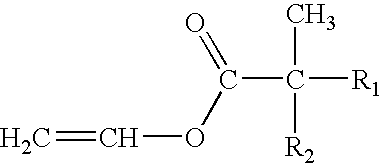Self-crosslinking dispersions utilizing acrylamide/N-alkylolacrylamide crosslinking mixture with C2-C10 alkylol
a technology of crosslinking mixture and acrylamide, which is applied in the field of self-crosslinking polymer dispersions, can solve the problems of not providing formaldehyde-free systems, not providing systems with significantly lower levels of free formaldehyde, and health hazards, and achieves the effects of reducing the residual alkylaldehyde level, reducing the adverse effects of free aldehyde on the binder, and reducing the level of residual aldehyde levels
- Summary
- Abstract
- Description
- Claims
- Application Information
AI Technical Summary
Benefits of technology
Problems solved by technology
Method used
Image
Examples
example 1
[0019]The following procedure was used to prepare an aqueous vinyl acetate dispersion of the invention.
[0020]480.0 g of deionized water, 3.0 g of Aerosol A-102, 15.00 g of a 25% aqueous solution of sodium vinyl sulfonate (SVS), 0.12 g sodium acetate, 3.60 g of Igepal CA-887, 0.6 g of sodium formaldehyde sulfoxylate (SFS), 2.40 g of a 1% aqueous solution of Versene 100 and 2.40 g of a 1% aqueous solution of ferrous sulfate was added to a one liter glass reactor. Enough phosphoric acid was provided to adjust the pH to between 3.8 and 4.2. While stirring, the vessel was purged with a nitrogen flow. After 10 minutes, the reactor was heated to 65° C. for initiation; however, when the temperature in the reactor reached 50° C., 60.0 g of vinyl acetate was added to the reactor followed by other ingredients as specified. When the temperature in the reactor was 58° C. (and thereafter), an aqueous solution of 2.64 g t-butyl hydroperoxide in 60.0 g of deionized water was slowly added to the rea...
example 2
[0021]The following procedure was used to prepare an aqueous ethylene / vinyl acetate dispersion of the invention.
[0022]1610.0 g of deionized water, 14.0 g of a 1% aqueous solution of ferrous sulfate, 84.0 g of SVS, 87.5 g Hostapur SAS30, 58.45 g of Polystep TD 189, 14.0 g of a 1% aqueous solution of Versene 100, 1.75 g of sodium sulfate and 1.575 g of sodium erythorbate was added to a ten liter steel reactor. Enough phosphoric acid was added to adjust the pH to 3.8, then 2870.0 g of vinyl acetate was added and the reactor was pressurized with ethylene to 750 psi. While stirring at 500 rpm, the vessel was allowed to come to equilibrium. Once the reactor was at equilibrium (and thereafter) the agitation was reduced to 400 rpm, an aqueous solution of 17.5 g of t-butyl hydroperoxide in 210.0 g of deionized water was slowly added along with an aqueous solution of 14.0 g of sodium erythorbate in 210.0 g of deionized water. The total delay time for these two slow-adds was about three hours....
PUM
| Property | Measurement | Unit |
|---|---|---|
| molar ratio | aaaaa | aaaaa |
| molar ratio | aaaaa | aaaaa |
| molar ratio | aaaaa | aaaaa |
Abstract
Description
Claims
Application Information
 Login to View More
Login to View More - R&D
- Intellectual Property
- Life Sciences
- Materials
- Tech Scout
- Unparalleled Data Quality
- Higher Quality Content
- 60% Fewer Hallucinations
Browse by: Latest US Patents, China's latest patents, Technical Efficacy Thesaurus, Application Domain, Technology Topic, Popular Technical Reports.
© 2025 PatSnap. All rights reserved.Legal|Privacy policy|Modern Slavery Act Transparency Statement|Sitemap|About US| Contact US: help@patsnap.com


